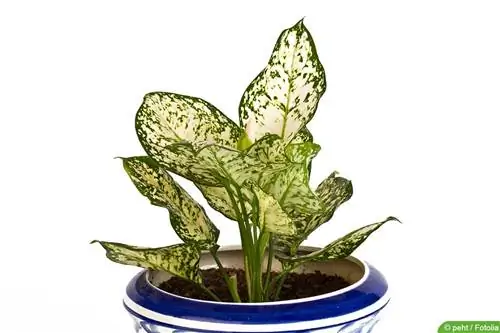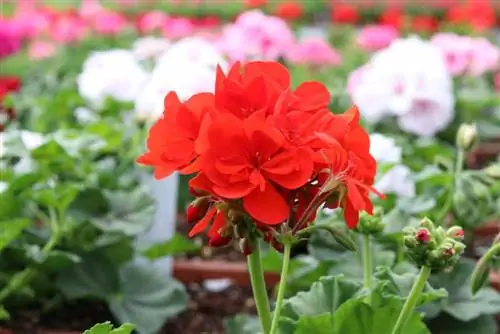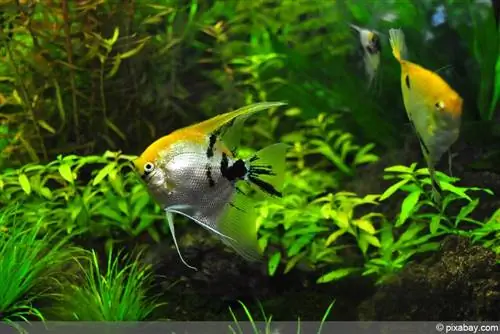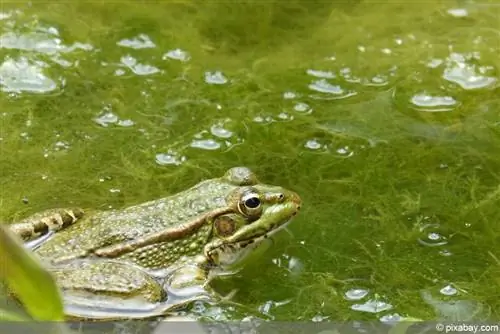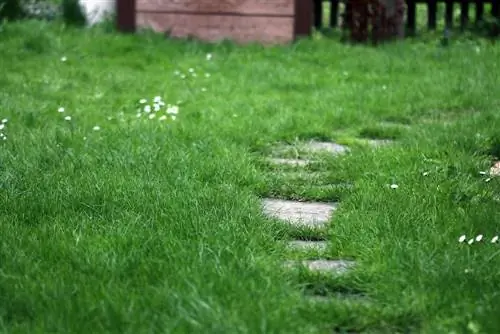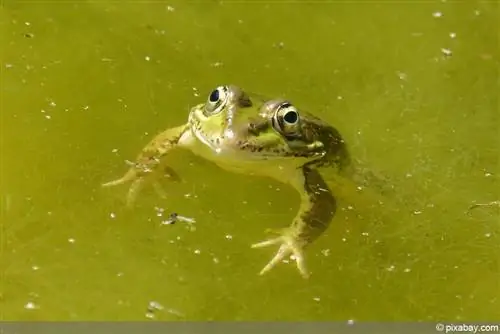- Author admin [email protected].
- Public 2023-12-17 03:39.
- Last modified 2025-01-24 12:45.
The cob thread fits in the living room as well as in the office and, in addition to creating a tropical flair, can also improve the room climate. Tips for care from A to Z can be found here.
Profile
- belongs to the arum family
- is known in botanical terminology as Aglaonema
- reaches heights between 50 and 100 centimeters
- evergreen plant
- not hardy
- poisonous in all parts
- decorative patterned leaves
- positive influence on the indoor climate
- originally from the tropics
- requires only a little water
Location
As a plant of tropical origin, the cob filament requires a warm, sunny and protected location. Places near a south-facing window or, alternatively, the use of a plant lamp are ideal. During the summer the plant can also be grown on the balcony or in the garden. However, only when frost or temperatures of less than 10 degrees Celsius are no longer expected. The plant should also not be exposed to heavy rain or wind.
Protected corners near the house wall on a balcony or terrace are ideal. The plant can also be cultivated indoors all year round. In any case, the care needs to be adjusted accordingly but is simple.
Substrate
Aglaonema require substrate that meets certain factors. These are:
- loose, permeable texture
- moderate water storage
- medium nutrient content
For example, normal plant soil or palm soil to which coconut fibers are added is ideal. There should also be a drainage layer at the bottom of the pot. This can consist, for example, of pottery shards or coarse gravel. A three to five centimeter high layer is optimal to prevent waterlogging and prevent rot.
Tip:
An alternative to potting soil and coconut fiber is potting soil with perlite.
Pouring
There are only four factors to consider when watering the cob thread:
- the water should be at room temperature and not cold
- low-calcium, soft water is preferred
- In summer the soil should be kept slightly moist at all times
- In winter the substrate is allowed to dry on the surface
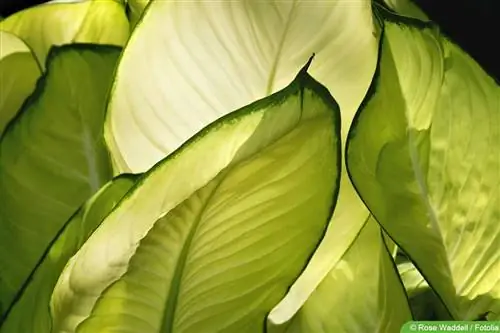
It therefore makes sense to water only a little at a time and to use soft water. For example, the following are well suited:
- stale or soft tap water
- Aquarium water
- filtered tap water
- Rainwater
- Pond water
The advantages of aquarium water or pond water are that it contains important nutrients. However, this only applies as long as no chemical agents have been used to kill algae, for example.
Tip:
If you don't know whether the tap water is hard or soft, you can ask the regional waterworks. The degree of hardness can often be found out quickly and easily via the respective homepage. Another option is to determine the lime content using text strips.
Fertilize
A liquid complete fertilizer for houseplants should be administered from March to October. When dosing, pay attention to the manufacturer's instructions. As a rule, one dose every four weeks is sufficient. It is important that the fertilizer is dissolved directly in the irrigation water. On the one hand, this achieves an optimal distribution. On the other hand, it prevents so-called chemical burns from occurring on the roots. If the components are too concentrated, they can cause unfavorable reactions.
Propagate
Aglaonema can be propagated in three different ways. By:
- offshoot
- Cuttings
- Division
offshoot
Offshoots appear on the mother plant after several years and grow out of the soil next to her. When repotting, they are separated from the adult plant in the root area using a sharp knife or scissors. The interfaces should then be allowed to dry, the young plant is placed in substrate and watered.
Cuttings
In the spring after the first shoots, strong side shoots that are at least 15 centimeters long and have at least three leaves are cut off. The foliage is removed except for the top leaf. The cutting is inserted three to five centimeters deep into nutrient-poor soil, placed in a warm, partially shaded place and the substrate is kept moist throughout. Potting soil, for example, is suitable as a substrate. The fact that rooting is successful can usually be seen after just a few weeks when new shoots grow back.
Division
If the Aglaonema is very large and sprawling, it is recommended to propagate it by division. During repotting, the root ball is cut in the middle. The interfaces on the roots should be allowed to dry for a few hours before the two daughter plants are placed in the fresh substrate.
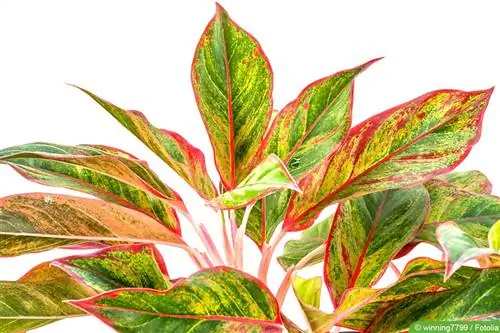
Wintering
Approximately from November or December to the following February or March, the Aglaonema is in a dormant state. If there is little light, the plant should be kept cooler. 16 to 18 degrees Celsius is ideal. However, the location does not necessarily have to be changed. However, in heated rooms the lighting should be adjusted accordingly. A UV lamp can help. It is important during the winter that the watering is adjusted accordingly. The soil should never dry out completely. Small but regularly administered water doses are useful.
Repotting
The substrate can be changed in spring. Repotting is also recommended if growth increases and the planter is not large enough. The following procedure should be observed:
Adjust timing
Repotting should be done before new shoots appear in spring. Even after the first new shoots, a change in soil can still take place.
Remove substrate thoroughly
Removing the substrate thoroughly offers several advantages. On the one hand, this allows the roots to absorb nutrients more directly. Damage is detected and can be removed. On the other hand, diseases and pests that could spread through the substrate are prevented.
Remove dead plant parts
Withered leaves or dead shoots, rotten roots and otherwise damaged plant parts should be removed immediately when repotting.
Planting
After removing withered parts and briefly drying the interfaces, the plant can be planted in fresh substrate and, if necessary, in a larger container. It is important to ensure that the plant pot is stable and stable as it gets larger. In addition, the plant should not be covered with soil higher than before.
Pouring
To accelerate the growth of the roots, the cob thread should be watered well. Watering makes sense, but waterlogging should be avoided.
Blend
A cutting is only necessary in special cases when caring for Aglaonema. These include, for example:
- damaged plant parts
- dried or withered flowers
- sections affected by diseases or pests
No matter why the plant needs to be pruned, there are a few basic rules to follow in any case. These include:
- disinfected pruning tools
- sharp blades
- Allow interfaces to dry
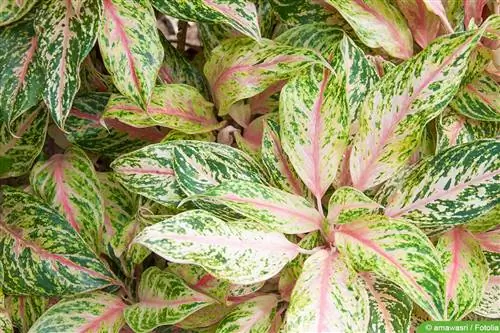
Caution: poisonous
The bulb thread is poisonous in all parts. Therefore, some precautions must be followed when handling the plant. These include:
- wear gloves when cutting
- Avoid direct skin contact with escaping plant sap
- place out of reach of children and pets
- Clean pruning tools after removing plant parts
Diseases, pests and care errors
Pests usually stay away from the cob thread. Fungal diseases and rot, however, are not uncommon. These are often due to errors in care.
For example, choosing the wrong substrate can cause the soil to become compacted and waterlogged. Too frequent watering or excessive watering can also cause mold to form on the soil.
If the cob filament is warm but dark, growth may suffer and parts of the plant may wither. It is also usually noticeable that the leaf color is fading. However, the reason for this can also be found in a lack of nutrients in the substrate. Regular fertilization and repotting every three years at the latest can help.

